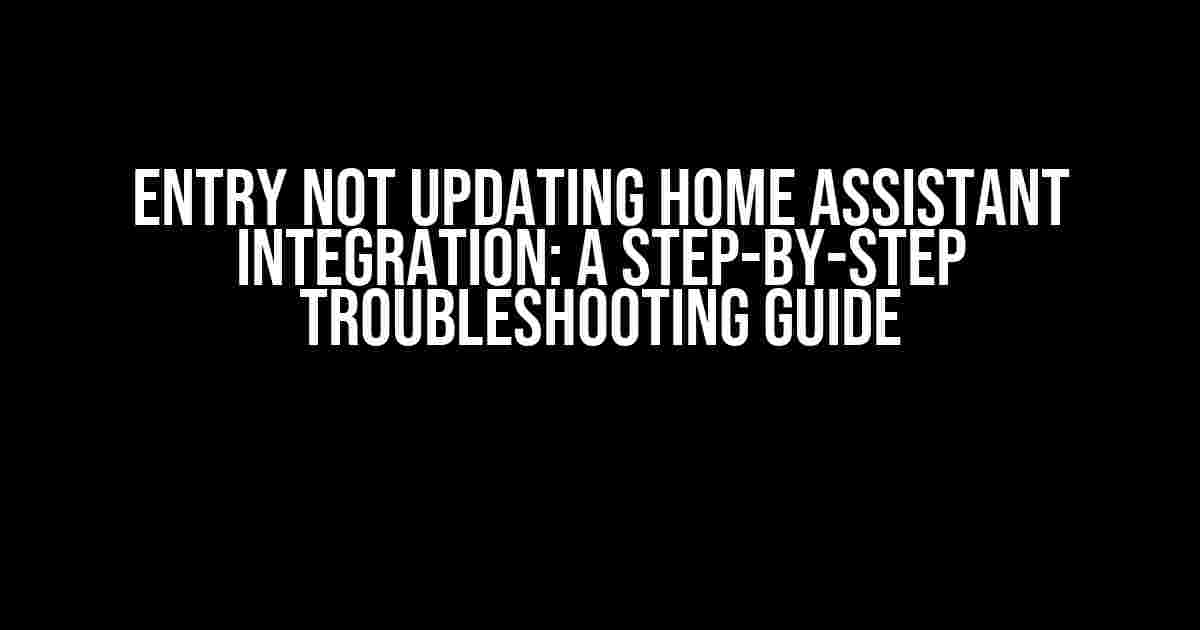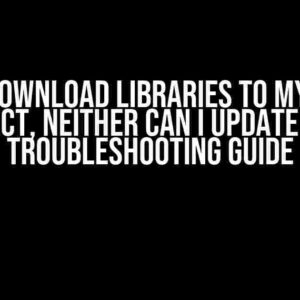Are you frustrated with your Home Assistant integration not updating properly? You’re not alone! In this comprehensive guide, we’ll take you through a series of troubleshooting steps to help you identify and fix the issue, ensuring your smart home system is always up-to-date and running smoothly.
- Prerequisites
- Step 1: Check the Home Assistant Logs
- Step 2: Verify Integration Configuration
- Step 3: Check Device or Service Status
- Step 4: Inspect Network Connectivity
- Step 5: Restart Home Assistant and Device/Service
- Step 6: Check for Home Assistant Updates
- Step 7: Reconfigure Integration
- Conclusion
Prerequisites
Before we dive into the troubleshooting process, make sure you’ve met the following prerequisites:
- Home Assistant is installed and configured correctly on your system.
- You have a working integration setup with the device or service that’s not updating.
- You’ve checked the device or service’s status page to ensure it’s online and functioning correctly.
Step 1: Check the Home Assistant Logs
The first step in troubleshooting is to review the Home Assistant logs to identify any potential issues. To access the logs, follow these steps:
- Open the Home Assistant web interface and navigate to the
Developer Toolssection. - Click on the
Logstab. - Filter the logs by selecting the relevant integration (e.g.,
zwaveormqtt) from the dropdown menu. - Look for any error messages or warnings related to the integration or device.
Example log output:
2023-02-20 14:30:00 INFO (MainThread) [homeassistant.components.zwave] Z-Wave configuration updated
2023-02-20 14:30:05 ERROR (MainThread) [homeassistant.components.zwave] Error updating device 'Living Room Lamp': timeout waiting for responseStep 2: Verify Integration Configuration
Next, let’s verify that the integration is configured correctly:
- Open the Home Assistant web interface and navigate to the
Settingssection. - Click on the
Integrationstab. - Find the integration that’s not updating and click on the three vertical dots to edit.
- Review the integration’s configuration settings, making sure:
- API keys or usernames and passwords are correct and up-to-date.
- Device or service URLs are accurate and reachable.
- Any required dependencies or libraries are installed and configured correctly.
Step 3: Check Device or Service Status
Ensure the device or service is online and functioning correctly:
- Check the device or service’s status page to confirm it’s online and responding.
- Verify that the device or service is properly paired with Home Assistant.
- Restart the device or service to ensure it’s not experiencing temporary connectivity issues.
| Device/Service | Status Page |
|---|---|
| Z-Wave Hub | http://zwave-hub.local:8083/status |
| MQTT Broker | http://mqtt-broker.local:1883/status |
Step 4: Inspect Network Connectivity
Network connectivity issues can prevent Home Assistant from updating correctly:
- Check your network configuration to ensure Home Assistant can reach the device or service.
- Verify that the device or service is connected to the same network as Home Assistant.
- Use tools like
pingornslookupto test network connectivity:
Example command:
ping -c 1 zwave-hub.localStep 5: Restart Home Assistant and Device/Service
Sometimes, a simple restart can resolve the issue:
- Restart Home Assistant by running
sudo systemctl restart home-assistant(on Linux) or restarting the Home Assistant container (on Docker). - Restart the device or service to ensure it’s properly connected and responding.
Step 6: Check for Home Assistant Updates
Make sure you’re running the latest version of Home Assistant:
- Check the Home Assistant web interface for available updates.
- Update Home Assistant to the latest version using your preferred method (e.g.,
sudo pip3 install --upgrade homeassistantor updating the container).
Step 7: Reconfigure Integration
- Delete the existing integration configuration.
- Re-add the integration, ensuring correct configuration settings.
- Restart Home Assistant to apply the changes.
Conclusion
By following these troubleshooting steps, you should be able to identify and fix the issue preventing your Home Assistant integration from updating correctly. Remember to methodically work through each step, checking and verifying your configuration and network connectivity along the way. If you’re still experiencing issues, consider seeking help from the Home Assistant community or consulting the official documentation.
By following this guide, you’ll be back to enjoying a seamless smart home experience in no time!
Frequently Asked Question
Having trouble with your Home Assistant integration? Don’t worry, we’ve got you covered! Below are some frequently asked questions to help you troubleshoot the issue.
Why is my entry not updating in Home Assistant?
Make sure that you have correctly configured the Home Assistant integration in your settings. Check that the API key, API URL, and entity ID are correct. Also, ensure that the entity is enabled and available in Home Assistant.
What should I do if I’m getting a “Failed to update entity” error?
This error usually occurs due to incorrect API key or API URL. Double-check your Home Assistant API key and URL to ensure they are correct and up-to-date. If you’re still experiencing issues, try resetting the API key or checking the Home Assistant logs for more information.
Why is my entry not updating in real-time?
Home Assistant has a polling interval that determines how often it checks for updates. You can adjust this interval in the Home Assistant settings. Additionally, make sure that your device is connected to the same network as Home Assistant and that the entity is correctly configured for real-time updates.
What if I’ve checked everything, but my entry is still not updating?
In this case, try restarting Home Assistant and check the logs for any errors. Also, ensure that your device is running the latest firmware and that the Home Assistant integration is up-to-date. If you’re still experiencing issues, you can reach out to our support team for further assistance.
Can I use multiple Home Assistant instances with the same device?
Yes, you can use multiple Home Assistant instances with the same device, but make sure to configure each instance with a unique API key and entity ID to avoid conflicts.



